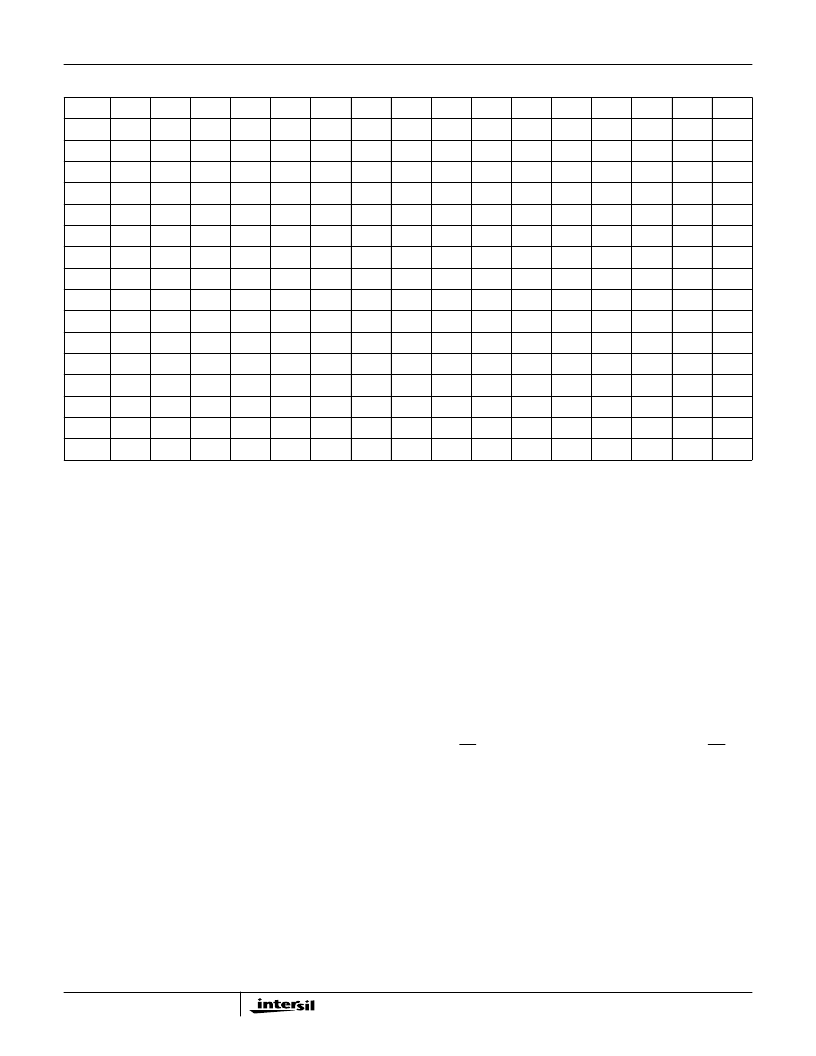- 您現(xiàn)在的位置:買賣IC網(wǎng) > PDF目錄385396 > HSP50215 (Intersil Corporation) Digital UpConverter(數(shù)字上變頻器) PDF資料下載
參數(shù)資料
| 型號(hào): | HSP50215 |
| 廠商: | Intersil Corporation |
| 英文描述: | Digital UpConverter(數(shù)字上變頻器) |
| 中文描述: | 數(shù)字上變頻器(數(shù)字上變頻器) |
| 文件頁數(shù): | 13/21頁 |
| 文件大?。?/td> | 162K |
| 代理商: | HSP50215 |

3-13
The convolution multiplies C0 by the most recent data
sample. For a 16 tap, interpolate-by-4 filter, the calculations
are:
OUTPUT0 = (C0*D[n]) + (C4*D[n-1]) + (C8*D[n-2]) +
(C12*D[n-3])
OUTPUT1 = (C1*D[n]) + (C5*D[n-1]) + (C9*D[n-2]) +
(C13*D[n-3])
OUTPUT2 = (C2*D[n]) + (C6*D[n-1]) + (C10*D[n-2]) +
(C14*D[n-3])
OUTPUT3 = (C3*D[n]) + (C7*D[n-1]) + (C11*D[n-2]) +
(C15*D[n-3])
Table 6 indicates how the I coefficients should be loaded for
this example. Notice that 16 filter coefficients are required.
All other addresses not used. The filter interpolates by 4
and the coefficients are loaded sequentially through the 4
interpolation phases starting at 512 - 515, then jumping to
528 - 531 for the next four addresses, and so on until 16
coefficients have been loaded.
Shaping filter Q coefficients are loaded from the first
coefficient (B0) in address 0x300h to the last address in
0x3FFh. The convolution multiplies B0 by the most recent
data sample. For a 16 tap, interpolate-by-4 filter, the
calculations are:
OUTPUT0 = (B0*D[n]) + (B4*D[n-1]) + (B8*D[n-2]) +
(B12*D[n-3])
OUTPUT1 = (B1*D[n]) + (B5*D[n-1]) + (B9*D[n-2]) +
(B13*D[n-3])
OUTPUT2 = (B2*D[n]) + (B6*D[n-1]) + (B10*D[n-2]) +
(B14*D[n-3])
OUTPUT3 = (B3*D[n]) + (B7*D[n-1]) + (B11*D[n-2]) +
(B15*D[n-3])
Table 7 indicates how the Q coefficients should be loaded for
this example. Identical to the I filter, notice that since 16 filter
coefficients are required. All other addresses not used. The
filter interpolates by 4, and the coefficients are loaded
sequentially through the 4 interpolation phases, starting at
768-771, then jumping to 784-787 for the next four addresses,
and so on until 16 coefficients have been loaded.
Microprocessor Read
The DUC offers the microprocessor access to all of the
control data configuration registers through a read process.
The shaping filter coefficients, however, cannot be read.
With CE asserted, a “read” consists of dropping the RD line
low to transfer data from the register addresses selected by
A(9:0). The read address mapping is provided in Table 8.
The timing is detailed in Figure 15.
TABLE 6. Q SHAPING FILTER COEFFICIENT ADDRESSES
DS
0
DS
1
DS
2
DS
3
DS
4
DS
5
DS
6
DS
7
DS
8
DS
9
DS
10
DS
11
DS
12
DS
13
DS
14
DS
15
IP0
768
784
800
816
832
848
864
880
896
912
928
944
960
976
992
1008
IP1
769
785
801
817
833
849
865
881
897
913
929
945
961
977
993
1009
IP2
770
786
802
818
834
850
866
882
898
914
930
946
962
978
994
1010
IP3
771
787
803
819
835
851
867
883
899
915
931
947
963
979
995
1011
IP4
772
788
804
820
836
852
868
884
900
916
932
948
964
980
996
1012
IP5
773
789
805
821
837
853
869
885
901
917
933
949
965
981
997
1013
IP6
774
790
806
822
838
854
870
886
902
918
934
950
966
982
998
1014
IP7
775
791
807
823
839
855
871
887
903
919
935
951
967
983
999
1015
IP8
776
792
808
824
840
856
872
888
904
920
936
952
968
984
1000
1016
IP9
777
793
809
825
841
857
873
889
905
921
937
953
969
985
1001
1017
IP10
778
794
810
826
842
858
874
890
906
922
938
954
970
986
1002
1018
IP11
779
795
811
827
843
859
875
891
907
923
939
955
971
987
1003
1019
IP12
780
796
812
828
844
860
876
892
908
924
940
956
972
988
1004
1020
IP13
781
797
813
829
845
861
877
893
909
925
941
957
973
989
1005
1021
IP14
782
798
814
830
846
862
878
894
910
926
942
958
974
990
1006
1022
IP15
783
799
815
831
847
863
879
895
911
927
943
959
975
991
1007
1023
HSP50215
相關(guān)PDF資料 |
PDF描述 |
|---|---|
| HSP50216 | Four-Channel Programmable Digital DownConverter(四通道可編程數(shù)字下變頻器) |
| HSP50307 | Burst QPSK Modulator(混合信號(hào)QPSK調(diào)制器) |
| HSP50415VI | CABLE ASSEMBLY; 75 OHM TNC MALE TO 75 OHM TNC MALE; 75 OHM, RG6A/U COAX |
| HSP50415EVAL1 | HSP50415EVAL1 Evaluation Kit |
| HSP9501 | Programmable Data Buffer(可編程數(shù)據(jù)緩沖器) |
相關(guān)代理商/技術(shù)參數(shù) |
參數(shù)描述 |
|---|---|
| HSP50215EVAL | 制造商:INTERSIL 制造商全稱:Intersil Corporation 功能描述:DSP Modulator Evaluation Board |
| HSP50215VC | 制造商:INTERSIL 制造商全稱:Intersil Corporation 功能描述:Digital UpConverter |
| HSP50215VI | 制造商:INTERSIL 制造商全稱:Intersil Corporation 功能描述:Digital UpConverter |
| HSP50216 | 制造商:INTERSIL 制造商全稱:Intersil Corporation 功能描述:Four-Channel Programmable Digital Downconverter |
| HSP50216_06 | 制造商:INTERSIL 制造商全稱:Intersil Corporation 功能描述:Four-Channel Programmable Digital DownConverter |
發(fā)布緊急采購,3分鐘左右您將得到回復(fù)。